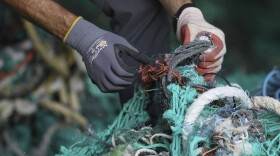The controversial sports project planned for Waimanalo would be no more under a city plan announced at a neighborhood board meeting Monday night. The announcement represents a change in direction for the administration of Mayor Kirk Caldwell, who had once defended the project in the face of mounting opposition.
The city is now offering a compromise that would stop the construction of a playground that was part of a phased development of a sports complex. In its place would be a historical and cultural education park with native Hawaiian plants.
Future phases of the Waimanalo Bay Beach Park sports project would also be abandoned, City Managing Director Roy Amemiya told the board and community members. Mayor Caldwell was not present at the meeting.
Amemiya said the city cannot simply leave the park as it is now because the work had already started.
The City Council will need to approve the plans, which would be submitted in the form of a resolution.
City Council Chair Ikaika Anderson, who represents the area, attended the neighborhood board meeting but said he was not included in discussions leading to the latest plans until the last one, which he could not attend.
“The fact that the mayor was holding the meetings with HPD and members of the community is what caught me off guard because I wasn't made aware that those meetings were taking place until after they'd already started,” he said. "But I do feel strongly, and I've shared this position with the mayor, that we should continue these discussions but ensure that all sides are represented.”
Amemiya said Anderson's exclusion was not an oversight, but the meetings were held in secret because their mediator felt that "the people in the room were the ones who needed to be there." He explained that as time progressed, it became harder to include more people in the discussion.
Anderson, who originally supported the sports project, said he was not advocating for either side but wanted to ensure all views were heard.
Controversy over the park's development had grown over the past year as opponents took inspiration from the protest against the construction of the Thirty Meter Telescope on Mauna Kea.
About two dozen people were arrested during one demonstration in September at Sherwood Forest, the wooded area of the park. The petty misdemeanor cases were dismissed last week by a district court judge over questions about the legal definition of obstruction, Hawaii News Now reported.
As community opposition grew, the city stepped back from the original plans for a multi-phase sports complex in the park.
Caldwell announced on Twitter in September that he would not be going through with the next phases of the sports complex master plan and would only complete phase one, which was the construction of a small playground, a sports field and an 11-stall parking lot.
In October, a possible historical artifact was found in the park that put the project on hold while opponents maintained that iwi or ancient bones were buried there.
To develop the new proposal, the administration met privately with some community representatives who are part of the Save Our Sherwoods protest over the last two-and-a-half months.
“We’ve been doing our research, doing our homework,” said Kuike Kamakea Ohelo, one of the community representatives who attended the meetings. “I think that was done in cooperation with law enforcement . . . working with us and actually taking our suggestions, ideas, research and finding out that, you know what, these guys is right.”
Amemiya explained that the construction so far has left the land in violation of soil erosion laws so the city cannot completely abandon the project.
Instead, the city will be leveling out the uprooted park, putting in irrigation, removing the new playground foundation and planting grass and native plants.
The proposal would also change the name of Waimanalo Beach Park to Hunananiho Cultural and Historic Park.
Kalani Kalima, another protester who was part of the meetings leading to the latest proposal, said Hunananiho was the name of the area's place of refuge.
“Hunananiho is just as significant to us as Punchbowl is to the veterans of Hawaii,” he said. “It is that deep and the reason why we continue to try to protect it.”
Amemiya said the proposed project would take about 120 days to complete.




